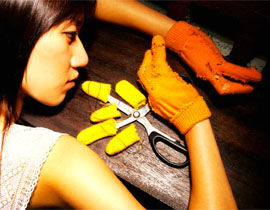
Body Talk

by Anjulie Rao (MA 2014)
Human bodies are storytellers. Even without our voices, our bodies spin yarns about our experience; every scar, crease, and bump possesses a narrative that, though it is told in silence, is spoken daily and directly to the public. The work of SAIC alum Sandie Yi (BFA 2003, MA 2005) brings to light the narratives of the body—specifically by exploring disability as an aesthetic She crafts wearable objects that give a voice to the body's narrative.
Yi herself was born in Taiwan with two fingers on each hand, and two toes on each foot. These two facts led to layered issues; the culture of disability in Taiwan, as described by Yi, "is seen as a personal, medical problem and disabled people are expected to conform to the normative standard. [They] praise disabled people who manage to exhibit achievements and behaviors like the nondisabled." This, says Yi, encouraged her to shy away from her own body and bodily experience.
After coming to SAIC, Yi developed tremendous confidence in her work—as well as in her body. Through metal shop, fashion design, and art therapy classes, Yi was challenged to confront her inner struggles with beauty and disability. She explains, "I was dealing with my desire to be recognized for who I was on the inside because people always make a big deal out of my disability. [SAIC] helped me to articulate pain and memories of disability oppression hidden in the unconscious. They challenged me to explore the meaning of bodies through making wearable items. They lit my passion for making body adornments as a way to connect with myself as art."
From there, Yi created an ongoing project: Crip Couture. Originally, the works (which combine material studies with fashion objects) centered on her own experiences, what she calls "the social interactions with the public—staring, screaming, and questioning—that focused on my appearance." These works include tailored gloves for her hands, as well as Animal Instinct Footwear that uses a large "claw" set between her two toes, allowing her to "fight you like a wild animal."
After returning to Taiwan, she received a grant to travel Taiwan to visit families with children and adults who were living with missing limbs. The experience forced her to revisit painful memories from her childhood. She also began working as an art therapist with various nonprofits, so she could engage with individuals to help them express their experiences with the public through art. She says, "The process is very much about creating a sense of community for each other."
Most recently, Yi has been creating new fashion designs. This time, she is creating wearable objects for other disabled peoples' bodies, exploring their physical and personal narratives regarding memories of medical and surgical intervention.
"The process of making such work often required long hours of person-to-person conversations with the disabled person," states Yi, "We would share the experiences of having disabilities, surgical procedures, and the meanings of having body alterations and bodily differences. I would use materials and textures to echo back to the narratives of each person in my art."
These materials—metals, found objects, latex, leather, etc.—are used as a means of reappropriating the purpose of prosthetics and orthotics, reflecting her conversations on and processes of body alterations, including scars, skin grafts, and the ethical and medical decisions made when undergoing body-altering procedures.
Yi's works are true fashion statements, allowing materials and wearability to tell the story of disability. "Crip Couture aims to create a culture and sense of community for people to reposition and redefine what fashion and bodies look like in our society...the boundary between ethics and aesthetics; the idea of the body in flux; and reclaiming the body. The objects and their wearers call for a recognition of collective human experience and suggest the possibility for a new genre of wearable art: disability fashion," says Yi.
Within disability fashion lies community, and Yi's work, along with the relentless, forward-thinking work of disability activists, is giving a voice to those who seek community—a place where bodies can speak without judgment.
